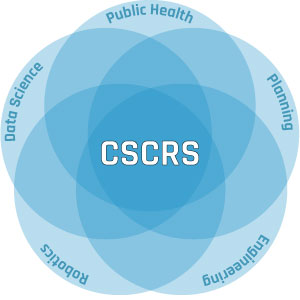ABOUT
The Collaborative Sciences Center for Road Safety (CSCRS) is a National University Transportation Center supporting the FAST Act research priority of promoting safety. It is one of the U.S. Department of Transportation’s five National University Transportation Centers announced December 2016. This flyer offers a helpful summary of CSCRS and its programs.
Led by the UNC Highway Safety Research Center in collaboration with the UNC Department of City and Regional Planning and the UNC Injury Prevention Research Center, CSCRS unites leading transportation research, planning, public health, data science and engineering programs at:
- Duke University
- Florida Atlantic University
- University of California, Berkeley
- University of North Carolina, Chapel Hill
- University of Tennessee, Knoxville
Our Mission and Vision
Mission: To create and exchange knowledge to advance transportation safety through a multidisciplinary, systems-based approach.
Vision: To unite perspectives from planning, engineering, public health, data science, and robotics in ways that advance road safety research and equip professionals and the public at large with cutting-edge tools, data, and resources to address the systems that impact transportation safety.
Safe Systems Approach
What is a Safe Systems approach to safety? It depends to whom you’re talking, because different audiences view the term in different ways.
In the transportation field, many think of the concept that originated in Sweden in the 1990s and has since been adopted in other countries. A core tenet of this approach is that even though road users make mistakes, these mistakes should not result in death, so the model envisions a roadway system designed to prevent death despite human errors. This perspective also acknowledges that a safe system requires a specific method focusing on the built environment and a proactive approach to address risk.
Additionally, “systems thinking” or “systems science” concepts from other disciplines offer an opportunity to expand upon the Swedish approach. In the public health field, systems science requires collaborative problem-solving and directing partners toward a shared vision. The public health community has also developed a robust set of qualitative and quantitative tools and methods to help understand the elements in a complex system.
Dive deeper into CSCRS’s take on Safe Systems here.






